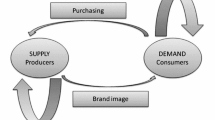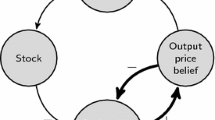Abstract
We present an agent-based market model in which social emulation by consumers and the adaptation of producers to demand play a significant role. Our theoretical approach considers boundedly-rational agents, heterogeneity of agents and product characteristics, and the co-evolution of consumers’ desires and firms’ adaptation efforts. The model reproduces, and allows us to interpret, statistical regularities which have been observed in the evolution of industrial sectors, and that seem to be also significant in the case of discretionary consumption activities. Thus, we suggest new determinants and explanations (from the consumer-side) for these stylized facts, and we obtain new theoretical patterns which may be of help to better understand the dynamics of discretionary goods markets. This model and results may contribute to guide future research on the field of consumer market.


















Similar content being viewed by others
Explore related subjects
Discover the latest articles, news and stories from top researchers in related subjects.Notes
Those goods which are not strictly necessary for everyday life.
Clearly these goods are heavily influenced by social emulation, and this could explain the emergence of consumer trends and the diversity of tastes.
The characteristic space is inspired by Lancaster (1966).
In each time period consumers only make one purchase decision but many social interactions can occur, which must take place sequentially in order to be implemented computationally. For this reason, periods are divided into steps and we use an asynchronous–random updating mechanism that sets the order in which consumers interact (see, for example, Miller and Page 2004).
We consider the Euclidean distance, although depending on the specific features of each product, other metrics might be more suitable.
We have considered that representative niches are those with a minimum size equivalent to 5 % of the population; clearly, other thresholds could be set up, but these changes produce no significant variations in the model dynamics.
This parameter can measure two kinds of market opacity. On the demand side, the uncertainty regarding the precise desires of the niche. On the supply side, it shows the possibility of not being able to satisfy exactly the consumer desires, or not knowing how to do it technically.
We are interested in proving that our model can show several well-known industrial patterns, which really requires finding only one specific parameter set that can generate them. In particular, in our simulations we take the default parameter values: N = 75, α = 24, β = 6, p = 0.003, r = 0.3, δ = 0.8, K = 0.1, M = 0.9, σ = 0.1, q = 0.05, λ = 0.003; although similar time evolutions of the system are obtained over a wide range of parameter values. All figures in this section have been obtained with these default parameter values and averaged from 500 replications (for different random seeds).
Characterized by the three aggregate variables: level of adoption \({{\varLambda }}\left( t \right)\), number of producers \(\prod \left( t \right)\) and Herfindahl index H(t).
We are only interested in proving the existence of a phase transition. The specific value of r that produces it, which depends on the values of the other parameters, is irrelevant for our purposes.
References
Addis M, Holbrook M (2001) On the conceptual link between mass customization and experimental consumption: an explosion of subjectivity. J Consum Behav 1:50–66
Agarwal S (2002) Restructuring seaside tourism. Ann Tour Res 29:25–55
Aversi R, Dosi G, Fagiolo G, Meacci M, Olivetti C (1999) Demand dynamics with socially evolving preferences. Ind Corp Change 8(2):353–408
Baudrillard J (1981) For a critique of the political economy of the signs. Telos Press, St. Louis
Becker GS (1996) Accounting for tastes. Harvard University Press, Cambridge
Bianchi M (ed) (1998) The active consumer. Routledge, London
Bianchi M (2002) Novelty, preferences and fashion: when goods are unsettling. J Econ Behav Organ 47:1–18
Bottazzi G, Secchi A (2003) Common properties and sectoral specificities in the dynamics of US manufacturing companies. Rev Ind Organ 23(3–4):217–232
Bottazzi G, Cefis E, Dosi G, Secchi A (2003) Invariances and diversities in the evolution of manufacturing industries (No. 2003/21). LEM Working Paper Series
Butler RW (2011) Tourism area life cycle. Goodfellow Publishers, Oxford
Camerer C, Loewenstein G, Prelec D (2005) Neuroeconomics: how neuroscience can inform economics. J Econ Lit 44:9–64
Cefis E (2003) Persistence in innovation and profitability. Rivista Internazionale di Scienze Sociali 110:19–37
Chai A, Earl P, Potts J (2007) Fashion, growth and welfare: an evolutionary approach. Adv Austrian Econ 10:187–207
Cowan R, Cowan W, Swann P (1997) A model of demand with interactions among consumers. Int J Ind Organ 15(6):711–732
De Vany A (2004) Hollywood economics. How extreme uncertainty shapes the film industry. Routledge, London
Deci E, Flaste R (1996) Why we do what we do: understanding self-motivation. Penguins Books, New York
Dosi G (2007) Statistical regularities in the evolution of industries. A guide through some evidence and challenges for the theory. In: Malerba F, Brusoni S (eds) Perspectives on innovation. Cambridge University Press, Cambridge, pp 153–186
Dosi G, Nelson RR (2010) Technical change and industrial dynamics as evolutionary processes. Hand Econ Innov 1:51–127
Evans DS (1987) Tests of alternative theories of firm growth. J Polit Econ 95:657–674
Fernández-Márquez CM, Vázquez FJ (2014) A simple emulation-based computational model. J Artif Soc Soc Simul 17(2):1–23
Fernández-Márquez CM, Fatás-Villafranca F, Vázquez FJ (2016) Endogenous demand and demanding consumers: a computational approach. Comput Econ (forthcoming)
Foxall GR (1990) Consumer psychology in behavioral perspective. Routledge, London
Gilbert D, Abdullah J (2004) Holiday taking and the sense of well-being. Ann Tour Res 31:103–121
Hall BH, Rosenberg N (eds) (2010) Handbook of the economics of innovation, vol 2. Elsevier-North Holland, New York
Hunt RWG (2004) The reproduction of colour. Wiley, Chichester
Jackson MO (2008) Social and economic networks. Princeton University Press, Oxford
Klepper S (1997) Industry life cycles. Ind Corp Change 6(1):145–182
Lancaster KJ (1966) A new approach to consumer theory. J Polit Econ 74(2):132–157
Lebergott S (1993) Pursuing happiness. American consumers in the 20th Century. Princeton University Press, Princeton
Leiss W (1983) The icons of the market place. Theory Cult Soc 1(3):10–21
Loasby B (2001) Cognition, imagination and institutions in demand creation. J Evolut Econ 11(1):7–21
Lotti F, Santarelli E, Vivarelli M (2003) Does Gibrat’s Law hold among young, small firms? J Evolut Econ 13(3):213–235
Malerba F, Nelson R, Orsenigo L, Winter S (2007) Demand, innovation, and the dynamics of market structure: the role of experimental users and diverse preferences. J Evolut Econ 17(4):371–399
Marsali M, Vega-Redondo F, Slanina F (2007) The rise and fall of a networked society: a formal model. Proc Natl Acad Sci USA 101:1439–1442
Miller JH, Page SE (2004) The standing ovation problem. Complexity 9(5):8–16
Moreau C, Lehmann D, Markman A (2001) Entrenched knowledge structure and consumer response to new products. J Mark Res 38:14–16
Mowery DC, Nelson RR (eds) (1999) Sources of industrial leadership: studies of seven industries. Cambridge University Press, Cambridge
Nelson RR, Consoli D (2010) An evolutionary theory of household consumption behavior. J Evolut Econ 20(5):665–687
Nelson RR, Winter SG (1982) An evolutionary theory of economic change. Belknap Press, Cambridge
North MJ, Collier NT, Vos JR (2006) Experiences creating three implementations of the repast agent modeling toolkit. ACM Trans Model Comput Simul 16(1):1–25
Pyka A, Fagiolo G (2007) Agent-based modelling: a methodology for neo-Schumpeterian economics. Elgar companion to neo-Schumpeterian economics [electronic resource], p 467
R Core Team (2015). R: a language and environment for statistical computing. R Foundation for Statistical Computing, Vienna. https://www.r-project.org/
Rabin D, Forget C (1998) The Dictionary of Beer and Brewing. Taylor and Francis, Chicago
Rixen M, Weigand J (2014) Agent-based simulation of policy induced diffusion of smart meters. Technol Forecast Soc Change 85:153–167
Stanley MH, Buldyrev SV, Havlin S, Mantegna RN, Salinger MA, Eugene Stanley H (1995) Zipf plots and the size distribution of firms. Econ Lett 49(4):453–457
Steenkamp J, Burgess S (2002) Optimum stimulation level and exploratory consumer behavior in an emerging consumer market. Int J Res Mark 19:131–150
Stigler GJ, Becker GS (1977) De gustibus non est disputandum. Am Econ Rev 67(2):76–90
Valente M (2003) A model of bounded rational consumers with endogenous preferences. SIE, University of L’Aquila (working paper)
Valente M (2012) Evolutionary demand: a model for boundedly rational consumers. J Evolut Econ 22(5):1029–1080
Veblen TB (1899) The theory of the leisure class: an economic study in the evolution of institutions. Macmillan, New York
Vogel H (1998) Entertainment industry economics. Cambridge University Press, Cambridge
Windrum P (2005) Heterogeneous preferences and new innovation cycles in mature industries: the amateur camera industry 1955–1974. Ind Corp Change 14:1043–1074
Witt U (ed) (2001) Escaping satiation. The demand side of economic growth. Springer, Berlin
Witt U (2005) From sensory to positivist utilitarianism and back: The rehabilitation of naturalistic conjectures in the theory of demand. Papers on economics and evolution. Max Planck Institute of Economics, Jena
Author information
Authors and Affiliations
Corresponding author
Appendix: Pseudo-code for replication
Appendix: Pseudo-code for replication
In this section we include a detailed algorithm that describes the specifications of the model in order to make it less ambiguous and reproducible for any researcher.


Rights and permissions
About this article
Cite this article
Fernández-Márquez, C.M., Fatas-Villafranca, F. & Vázquez, F.J. A computational consumer-driven market model: statistical properties and the underlying industry dynamics. Comput Math Organ Theory 23, 319–346 (2017). https://doi.org/10.1007/s10588-016-9230-4
Published:
Issue Date:
DOI: https://doi.org/10.1007/s10588-016-9230-4




